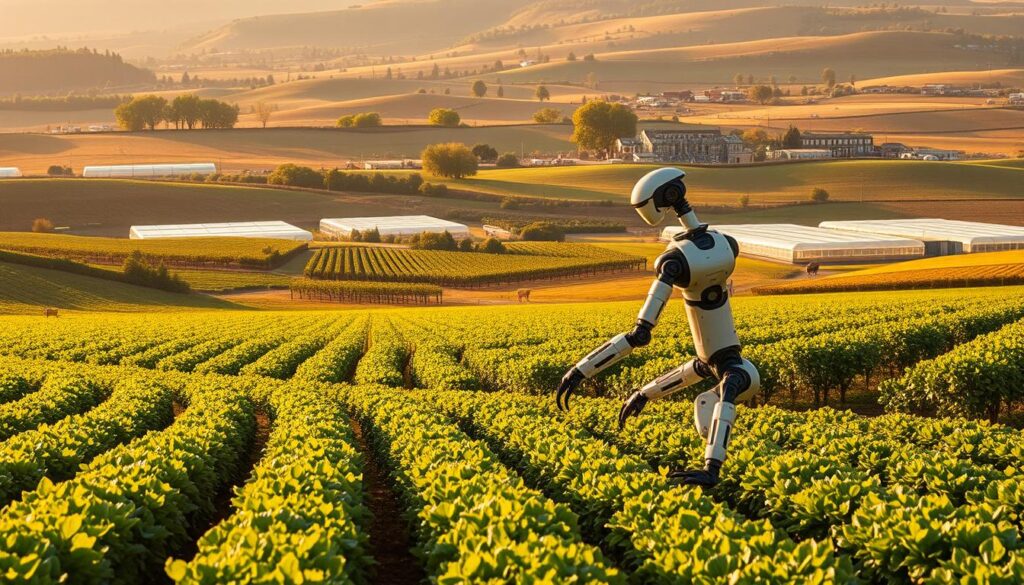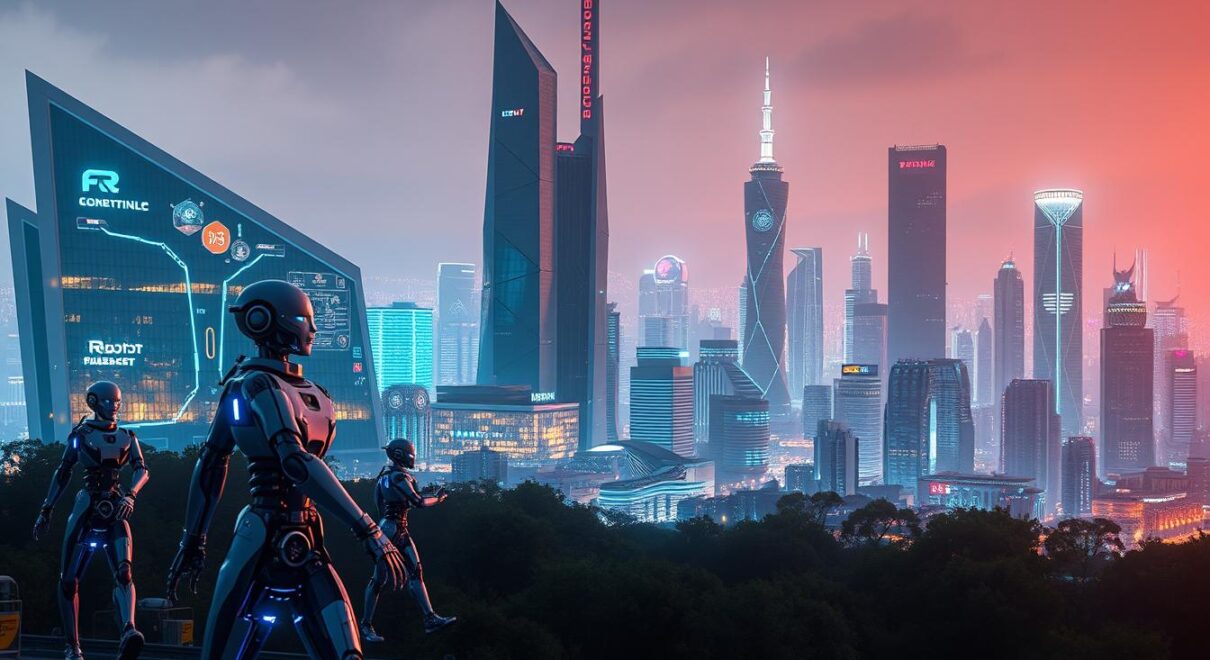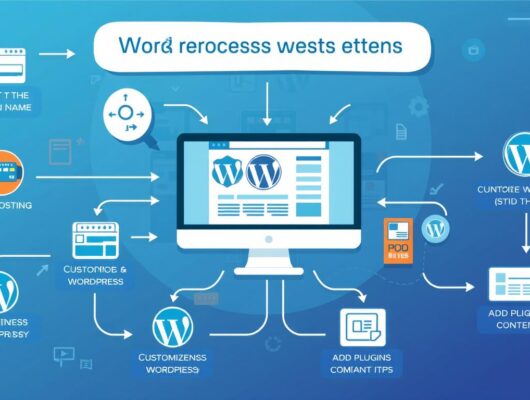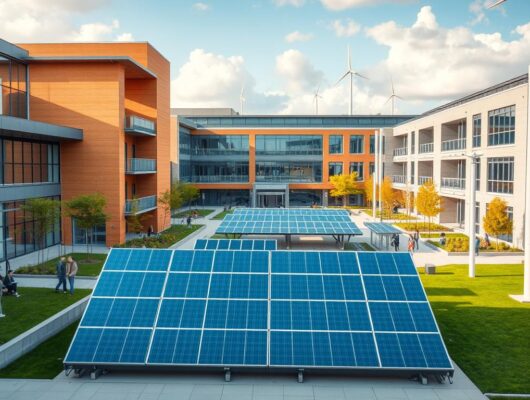Robotics technology is transforming industries worldwide. Robots are changing our work and life in factories and hospitals. Smart machines are emerging due to AI and automation advances.
The robotics market’s impact is significant. By 2024, global revenue will surpass $46 billion. Projections show growth to over $67 billion by 2028. These numbers reflect increasing reliance on robotic solutions.
The U.S. robotics market is thriving. It’s set to generate nearly $8 billion in 2024 alone. This growth is boosting productivity and efficiency across American industries.
Robotics and the Industrial Internet of Things (IIoT) are creating new opportunities. The IIoT market was worth $544 billion in 2022. It’s expected to reach $3.3 trillion by 2030.
This growth highlights the importance of connected robotic systems in modern industry. They’re becoming essential for businesses to stay competitive and efficient.
Key Takeaways
- Global robotics market to exceed $46 billion by 2024
- U.S. robotics revenue projected at $8 billion in 2024
- IIoT market expected to reach $3.3 trillion by 2030
- Robotics driving efficiency and productivity gains
- AI and automation fueling robotic innovation
- Increasing adoption across diverse industries
The Evolution of Modern Robotics Technology
Robotics technology has evolved dramatically since its early days. Simple industrial machines have transformed into complex intelligent systems. This journey has been marked by significant milestones and groundbreaking innovations.
From Industrial Automation to Intelligent Systems
Industrial robots first appeared in the 1960s. The Unimate, installed at General Motors in 1961, revolutionized assembly lines. It enhanced precision and reliability in hazardous tasks.
By the 1970s, robots had made a big impact. They reduced manufacturing costs and improved product quality. This was especially noticeable in automotive production.
Historical Development and Milestones
The evolution of robotics is marked by key advancements:
- 1804: The Jacquard Loom increased weaving speed by over 20 times
- 1959: Unimate robotic arm could follow 200 programmed movements
- 1969: Stanford Arm introduced electric power and computer control
- 1972: Shakey pioneered autonomous navigation using sensors
- 2002: Roomba marked widespread public acceptance of functional robots
Current State of Robotics Innovation
Robotics and automation now extend beyond manufacturing. Surgical robots like Da Vinci enable minimally invasive procedures. Autonomous robots inspect facilities in chemical, energy, and mining industries.
AI integration allows robots to learn, adapt, and make decisions. This pushes the boundaries of what’s possible in various sectors.
| Year | Innovation | Impact |
|---|---|---|
| 1961 | Unimate | Revolutionized assembly lines |
| 1997 | NASA’s Sojourner | First robotic rover on Mars |
| 2012 | Visual Recognition AI | 15.3% error rate in ImageNet competition |
The future of robotics looks promising. Advances in AI, machine learning, and quantum computing are on the horizon. These will lead to more sophisticated robotic systems capable of complex autonomous tasks.
Understanding the Convergence of AI and Robotics
AI and robotics are joining forces, creating a major tech breakthrough. This combo turns simple robots into smart, predictive systems. The impact spans industries, changing how we tackle automation and problem-solving.
Machine learning lets robots adapt to new situations. This turns pre-programmed tools into flexible, independent agents. In factories, AI robots handle tricky tasks alongside humans, boosting productivity and safety.
Robotic process automation (RPA) is shaking up industries by streamlining repetitive work. In logistics, AI robots make warehouses run smoother. They plan routes, manage stock, and fill orders with little human help.

Healthcare sees big gains from this tech team-up. AI-guided robots assist in surgeries and help patients recover. They also move supplies around hospitals efficiently. This combo improves both operations and patient care.
| Industry | AI-Robotic Application | Impact |
|---|---|---|
| Manufacturing | High-precision assembly | Increased productivity, reduced errors |
| Logistics | Automated picking and packing | Faster order fulfillment, optimized space usage |
| Healthcare | Surgical assistance, patient mobility | Enhanced precision, improved recovery times |
| Agriculture | Crop monitoring, harvesting | Increased yield, reduced labor costs |
The AI-robotics merge will keep sparking new ideas across industries. This tech evolution promises to boost efficiency, safety, and productivity. It’s set to reshape our world in amazing ways.
Transformative Impact on Manufacturing Industries
Industrial robotics is revolutionizing manufacturing, bringing a new era of efficiency and precision. Robotic systems in factories have improved production processes, quality control, and overall output. These advancements are changing the face of modern manufacturing.
Smart Factory Integration
Automation is key in smart factories. Advanced robotic systems streamline operations and boost productivity. BMW Group uses intelligent robots on assembly lines, working with humans to increase efficiency.
Assembly Line Optimization
Robotic systems have transformed assembly lines across industries. In automotive, robots handle welding, painting, and assembling with high precision. This automation enhances efficiency and reduces workplace injuries.
Quality Control Enhancement
Robotics technology is crucial for quality assurance. Advanced vision systems help robots detect tiny defects, ensuring high-quality products. This precision is valuable in electronics and pharmaceuticals, where consistency is key.
| Aspect | Impact of Industrial Robotics |
|---|---|
| Productivity | 24/7 operation, reduced cycle times |
| Safety | Reduction in workplace injuries |
| Quality | Improved consistency, fewer errors |
| Efficiency | Optimized workflows, reduced waste |
The initial investment in robotic systems can be substantial. However, many companies see significant returns within a few years. Increased productivity, better quality, and reduced labor costs make industrial robotics a game-changer.
Autonomous Systems and Their Applications

Autonomous systems are changing industries by working independently. They use AI and advanced sensors to perform tasks without human control. These robots are making work safer and more efficient in many fields.
In warehouses, Autonomous Mobile Robots (AMRs) move materials around. They use vision systems and lasers to navigate large spaces. This technology lets workers focus on important tasks instead of heavy lifting.
Robot navigation has improved greatly. The DARPA Grand Challenges showed big advances in self-driving cars. Today’s autonomous vehicles could reduce traffic accidents by 90% with quick decision-making.
- Industrial robotics market projected to reach $192.91 billion by 2032
- Manufacturing robots achieve 99% accuracy in complex tasks
- Agricultural drones survey land at speeds over 60 mph
Collaborative robots, or cobots, work alongside humans in factories. They can increase productivity by 30%. These robots use machine vision with 95% accuracy to recognize objects.
The future of autonomous systems is promising. IoT will connect 75 billion devices by 2025, leading to smarter automation. As robots and AI improve, they’ll find new uses across industries.
Human-Robot Collaboration in the Workplace
Modern workplaces are changing with human-robot interaction. Collaborative robots are becoming crucial in many sectors. This brings new challenges and chances for businesses and workers.
Safety Protocols and Standards
Safety is key in human-robot teamwork. Industry rules ensure robots work safely with humans. These cover force limits and speed control.
The goal is a secure space for humans and robots to work together. This allows for efficient side-by-side operations.
Collaborative Robot Design
Cobots are made for human interaction. They have rounded edges, force sensors, and easy-to-use controls. These features allow safe teamwork between humans and machines.
Cobots can adjust to their surroundings. This makes them great for many tasks across industries.
Training and Implementation Strategies
Good cobot use needs thorough training programs. Workers must learn how to work with these new helpers. Strategies focus on slow intro and ongoing support.
This method helps reduce problems and boost benefits of human-robot teamwork.
| Aspect | Human-Robot Collaboration Impact |
|---|---|
| Productivity | 85% increase in human-robot teams |
| Job Creation | Over 1 million new jobs since 2012 |
| Market Growth | 13% annual growth in robot production |
| Industry Adoption | 126 robots per 10,000 employees |
Human-robot teamwork is changing workplaces in many fields. Smart use of cobots can boost output and safety. This creates more efficient work spaces for everyone.
Healthcare Revolution Through Robotic Innovation
Robotics technology is transforming healthcare, bringing a new era of patient care. AI-integrated robotics has led to groundbreaking advancements in surgical precision and outcomes.
Surgical robots, like the Da Vinci system, offer AI-guided precision with minimal invasiveness. This leads to faster recovery times and better surgical outcomes for patients.
Medical robotics research has surged. In 2020, over 5,200 papers were published, compared to fewer than 10 in 1990.
Service robots boost hospital efficiency by handling tasks like medication delivery and disinfection. This allows healthcare professionals to focus more on patient care.
In pharmacy automation, robotic systems have cut medication errors by up to 50%. This significant improvement enhances patient safety.
Robotics is changing rehabilitation too. Soft exosuits, created by innovators like Conor Walsh, help stroke patients with walking.
These devices have shown great results. Some Parkinson’s patients can now walk normally without mid-gait freezing.
- Robotic surgical systems reduce patient trauma and speed up recovery
- AI-powered robots enhance diagnostic accuracy to over 90%
- Telepresence robots increase healthcare access by 30% in rural areas
The future of healthcare robotics is bright. The market is expected to grow 20% CAGR from 2023 to 2030.
We can expect more innovation in nanorobotics for targeted drug delivery and early disease detection. Robotics will play a key role in solving healthcare challenges.
Artificial Intelligence in Robotic Systems
AI and robotics are reshaping industries. This combo makes robots smarter and more adaptable. The AI robotics market will grow from $6.9 billion to $35.5 billion by 2026.

Machine Learning Integration
Machine learning helps robots learn from experience. In manufacturing, AI robots can predict equipment failures, reducing downtime by 30%. GE’s Brilliant Manufacturing Suite uses this tech in 500 factories worldwide.
Natural Language Processing
Natural language processing lets robots understand human speech. This tech improves human-robot interaction in service industries. Airbus’ CIMON-2 robot understands voice commands and helps astronauts in space.
Computer Vision Applications
Computer vision helps robots interpret visual information. It’s vital for quality control and inspection. Abyss Solutions uses this tech to speed up infrastructure inspections.
In the auto industry, Cruise operates self-driving cars in many cities. These cars use 360-degree cameras to create 3D maps of their surroundings.
AI in robotics is changing industries through autonomous task performance. AI-powered robots boost productivity, safety, and efficiency in various fields. This tech will likely bring more innovative applications in the future.
Logistics and Supply Chain Automation
Robotics and automation are revolutionizing the logistics industry. Companies use robotic process automation to streamline operations and boost efficiency. This helps meet customer demands for faster deliveries.

Mobile and collaborative robots have greatly improved warehouse efficiency. These tireless machines handle dangerous or mundane tasks. They work around the clock, increasing productivity compared to human workers.
Automated storage and retrieval systems (AS/RS) make the most of warehouse space. This helps cut costs related to building size and upkeep. These systems manage inventory with minimal errors.
- Autonomous robots are expected to see strong growth in supply chain operations
- Robotics systems can operate 24/7 without fatigue
- AS/RS systems maximize warehouse space and improve inventory management
Artificial intelligence enhances supply chain operations when combined with robotics. AI optimizes warehouse paths and predicts real-time demand. It also improves inventory management, reducing waste and increasing order accuracy.
Automating supply chains requires a large upfront investment. However, many companies report long-term savings and good returns. Robotics often lead to lower labor costs and improved safety.
Automation allows staff to focus on strategic work instead of repetitive tasks. This enhances employee value and job satisfaction.
Agricultural Robotics and Precision Farming
Robotics is changing farming with precision techniques. Autonomous systems are improving food production and sustainability. This new era addresses key challenges in agriculture.
Autonomous Harvesting Systems
Robotics is transforming harvesting methods. Autonomous systems work non-stop, increasing productivity without human limits. These robots plant seeds and apply pesticides with precision.
This technology significantly reduces post-harvest losses. It performs tasks more accurately than traditional methods.

Crop Monitoring Technologies
Robots like BoniRob are changing crop monitoring. This system tracks plant growth states continuously. It provides crucial data for plant breeders.
Some robots can place seeds and map fields with 2 cm accuracy. This precision helps farmers make better decisions.
Soil Analysis Automation
Automation has improved soil analysis. The AutoProbe system can sample 150 acres in an hour. It produces a quality sample every 45 seconds.
This quick, accurate analysis helps farmers plan fertilization and crop rotation. It leads to more efficient use of resources.
Agricultural robotics has a significant impact on farming. Robotic weed removal can increase crop yield by over 50%. The global AI agrimarket is growing rapidly.
In 2022, this market was valued at $1.37 billion. It’s expected to reach $11.13 billion by 2032. This growth shows the rising importance of robotics in agriculture.
Service Robots in Commercial Applications
Service robots are changing how businesses operate. They improve customer experiences and boost efficiency in retail, hospitality, and healthcare. These robots use advanced technology to perform various tasks.
In retail, AI-powered robots like Pepper interact with customers. They answer questions and offer personalized help. These robots can understand human emotions, creating unique shopping experiences.
Hospitality robots handle check-ins and deliver room service. They also provide concierge services. This frees up staff to focus on more complex tasks.
The International Federation of Robotics reports growth in service robot sales. Their annual survey shows increasing adoption across industries. Cleaning robots became popular during the Covid-19 pandemic.
Professional service robots need trained operators. They fall into eight groups, including agricultural and logistics robots. Consumer robots are easy to use and handle domestic tasks.
As AI improves, service robots become more advanced. They help with labor shortages and climate change issues. These robots are creating sustainable production systems.
The future of commercial robots looks promising. They’re set to change how businesses serve customers. Service robots will continue to transform various industries.
Advanced Sensor Technologies in Robotics
Robotics has made huge leaps forward due to advanced sensor tech. These innovations have changed how robots sense and interact with their surroundings. This has led to smarter, more adaptable systems.
Environmental Perception Systems
Modern robots use various sensors to understand their environment. LiDAR, cameras, and ultrasonic sensors team up to map the robot’s surroundings. This better perception helps robots navigate tricky spaces and work safely with humans.
Motion Detection Capabilities
Robot vision has improved greatly, allowing machines to spot and react to movement accurately. This advance is big for manufacturing. Robots can now work more safely and efficiently alongside humans.
Real-time Data Processing
AI is key in handling the huge amount of data from sensors. Real-time analysis lets robots make quick decisions. They can adapt to changing conditions on the spot.
| Sensor Type | Application | Benefit |
|---|---|---|
| Event Cameras | Drone Racing | High Temporal Resolution |
| Tactile Skins | Human-Robot Interaction | Enhanced Safety |
| Optical Fibers | Medical Robots | Precision Measurements |
| Quantum Sensors | Navigation | Unprecedented Accuracy |
These advanced sensors are sparking innovation across industries. In manufacturing, vision systems have sped up quality control. Healthcare benefits from robotic surgery systems like da Vinci, offering better precision.
As robotics keeps evolving, we can expect even more groundbreaking uses soon.
Robot Navigation and Spatial Awareness
Robot navigation has evolved dramatically since the Roomba’s debut. Modern robotics now powers delivery drones and self-driving cars on specific roads. Spatial AI aims to give machines human-like understanding of their surroundings.
SLAM (Simultaneous Localization and Mapping) is the core of this revolution. It allows robots to create maps while tracking their location. This technology enables autonomous systems to navigate complex spaces with increasing precision.
Open-source SLAM libraries have sped up robotics progress. These tools are used by researchers worldwide, promoting innovation and teamwork. MIT researchers developed a human-like navigation model using the Kimera library.
However, robot navigation still faces hurdles. Current robot perception can’t match a young child’s spatial awareness. Poor lighting and reflective surfaces can affect navigation accuracy.
Future advancements in robotics may include better multi-sensor fusion and cloud-based mapping. These improvements will further enhance the abilities of autonomous systems.
Future Trends in Robotics Design
Robotics technology is evolving rapidly, shaping many industries. Robot design adapts to meet new challenges and opportunities. Let’s explore emerging trends that are changing robotics.
Modular Architecture
Modular design in robotic systems allows for greater flexibility. This approach enables easy upgrades and customization for various applications. Manufacturers can create robots that adapt to changing needs without complete redesigns.
Sustainable Materials
Environmental concerns drive the use of sustainable materials in robot design. Biodegradable components and recycled materials are becoming more common. This shift reduces the environmental impact and aligns with global sustainability goals.
Energy Efficiency Innovations
Energy efficiency is a key focus in modern robotic systems. Advances in power management extend robot operational times. These innovations reduce environmental impact and improve practicality in remote operations.
| Design Trend | Benefits | Applications |
|---|---|---|
| Modular Architecture | Flexibility, Easy Upgrades | Manufacturing, Logistics |
| Sustainable Materials | Eco-friendly, Reduced Waste | Consumer Robotics, Agriculture |
| Energy Efficiency | Longer Operation, Lower Costs | Autonomous Vehicles, Space Exploration |
These trends address current challenges in robotics technology. They’re shaping robotic systems across industries, from manufacturing to healthcare. As innovations continue, we can expect more advanced and efficient robots soon.
Educational Applications of Robotics
Robotics is changing education, offering solutions for teacher shortages and better learning. In 2022-23, 23% of teachers left their schools. Robots now help overworked educators focus on complex subjects and student growth.
STEM education benefits greatly from robotics. VEX Robotics holds yearly contests that excite students about research, math, and science. LEGO MINDSTORMS, created with MIT, hosts global tournaments to boost interest in programming.
AI-powered robots create personalized learning experiences. Softbank Robotics’ NAO helps students learn new languages one-on-one. These robots excel in math and vocabulary, which need repetition and short answers.
For children with autism, robots like Kaspar improve communication skills. This shows how versatile educational robotics can be.
Robotics impacts education beyond classrooms. Medical students use robotic simulators to practice complex procedures safely. In special education, robotics helps students with various needs explore real-world scenarios.
As robotics technology advances, it continues to transform education for diverse learning styles. The potential seems endless.





